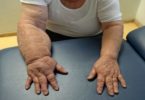What's in this article?
Nipple discharge Overview
Nipple discharge refers to any fluid that seeps out of the nipple of the breast.
Nipple discharge in a woman who’s not pregnant or breast-feeding isn’t necessarily abnormal, but it should be evaluated by a doctor. Nipple discharge in a man under any circumstances could be a problem and needs further evaluation.
One or both breasts may produce a nipple discharge, either spontaneously or when you squeeze your nipples or breasts. A nipple discharge may look milky, or it may be clear, yellow, green, brown or bloody. Nonmilk discharge comes out of your breasts through the same nipple openings that carry milk. The consistency of nipple discharge can vary it may be thick and sticky or thin and watery.
What is normal and what is abnormal nipple discharge?
Bloody nipple discharge is never normal. Other signs of abnormality include nipple discharge from only one breast and discharge that occurs spontaneously without anything touching, stimulating, or irritating your breast.
Color isn’t usually helpful in deciding if the discharge is normal or abnormal. Both abnormal and normal nipple discharge can be clear, yellow, white, or green in color.
Normal nipple discharge more commonly occurs in both nipples and is often released when the nipples are compressed or squeezed. Some women who are concerned about breast secretions may actually cause it to worsen. They do this by repeatedly squeezing their nipples to check for nipple discharge. In these instances, leaving the nipples alone for a while may help the condition to improve.
Based on your medical evaluation, your doctor will determine whether your nipple discharge is normal (physiologic) or abnormal (pathologic). Even if your doctor determines your breast discharge is abnormal, keep in mind that most pathological conditions that cause nipple discharge are not serious and are easily treated.
Causes of Nipple Discharge
Milky discharge (cloudy, whitish or almost clear in color, thin, non-sticky) is the most common type of discharge. Most milky discharge is caused by lactation or increased mechanical stimulation of the nipple due to fondling, suckling or irritation from clothing during exercise or activity. Drugs or hormones that stimulate prolactin secretion can cause spontaneous, persistent production of milk (galactorrhea). Prolactin is the hormone produced by the pituitary gland that starts the growth of the mammary glands and triggers production of milk. Some pituitary tumors cause excess prolactin secretion that can lead to milky nipple discharge, usually from both breasts (bilateral). Opalescent discharge that is yellow or green in color is normal.
Most bloody or watery (serous) nipple discharge (approximately 90%) is due to a benign condition such as papilloma or infection. A papilloma is a non-cancerous, wart-like tumor with a branching or stalk that has grown inside the breast duct. Papillomas frequently involve the large milk ducts near the nipple. Multiple papillomas may also be found in the small breast ducts further from the nipple.
Of the benign conditions that cause suspicious nipple discharge, approximately half is due to papilloma and the other half is a mixture of benign conditions such as fibrocystic conditions (i.e., lumpy) or duct ectasia (widening and hardening of the duct due to age or damage). For example, women with fibrocystic breasts may experience clear, yellow or light green discharge. Most opalescent discharge is due to duct ectasia or cyst.
Suspicious nipple discharge is due to cancer in about 10% of cases. That means, the vast majority nipple discharges are noncancerous. Discharge caused by a malignant condition is commonly on one side only. However, papillomas usually causes discharge from a single breast duct, so certainly not all unilateral discharges are associated with cancer. Nipple discharge can also be associated with a rare form of cancer called Paget’s disease of the nipple.
Signs of Paget’s disease usually only occur on one nipple and may include:
- persistent crustiness, scaliness, or redness of the nipple
- itching or burning of the nipple and surrounding areola
- bleeding or oozing from the nipple and areola
Signs Your Nipple Discharge Isn’t Serious
Thankfully, Nancy’s description tends to be more consistent with benign causes. Signs your nipple discharge isn’t serious include discharge that is:
- from both breasts
- easily produced by manipulation of the breasts
- white, clear, or milky
More Serious Signs of Nipple Discharge
On the other hand, signs that your breast discharge might be more serious include discharge that:
- occurs only in one breast
- is spontaneous
- is bloody or brown
- is associated with a breast mass
Treatment for Persistent Nipple Discharge
The standard treatment for nipple discharge that has no hormonal involvement is duct excision. Duct excision is usually performed on an outpatient basis with local anesthesia. The procedure is usually done through a small circular incision near the areolar border around the nipple. It is not uncommon for the pathology found to be so microscopic that it is invisible without the assistance of a microscope. Typically, nursing ability and nipple sensation are preserved after duct excision. Breast-feeding in the other breast should have no affect from the duct excision in the opposite breast.
There is usually not a significant change in breast size/shape after duct excision since only a small amount of tissue is removed. There is no evidence of increased future risk of breast cancer from the procedure. Some suggest that there may be a slight increase in risk of breast cancer for patients with a papilloma, but this possibly higher risk has nothing to do with the treatment chosen.





